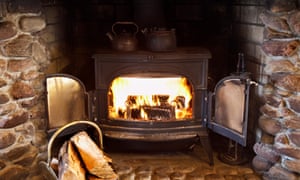It can cause eye irritation, breathing difficulties and heart disease. Here are ways to limit the damage

Outdoor air pollution caused three million premature deaths worldwide in 2012. Photograph: Halfpoint/Getty Images/iStockphoto
The European Commission has told the UK to clean up its air. Levels of nitrogen dioxide – which is linked to heart and lung disease and contributes to the early deaths of 40,000 people a year in the UK – are particularly bad. We’re not the only ones with filthy air; the five most-developed countries in the EU (Germany, France, Italy, Spain and the UK) are all in breach of the recommended limits and have been given two months to take action. Yet gone are the days of epic smogs, such as the great smog of 1952 that enveloped London in a thick fog for four days and killed an estimated 12,000 people. That crisis led to a new awareness of the dangers of air pollution and the need to protect our air with legislation. So surely our health is less at risk now?
Does air quality matter?
Yes. Ambient (outdoor air pollution) in cities and rural areas caused three million premature deaths worldwide in 2012 – predominately in low- and middle-income countries. And the World Health Organisation (WHO) is confident that, if we reduce air pollution, it would cut rates of stroke, heart disease, lung cancer, asthma and respiratory disease. Researchers at King’s College London (KCL) have recently confirmed that high levels of toxic air particles from traffic and combustion are associated with an increase in hospitalisations and deaths from heart and lung disease in children and younger adults.
But it is a huge task; in 2014, only 8% of the world’s population lived in places where the WHO air quality guidelines were met. The vast majority of us are breathing sub-standard air. Yet change is possible. According to the Department for Environment, Food and Rural Affairs (Defra), between 1970 and 2015, there was a long-term decrease in UK emissions of all air pollutants (ammonia, nitrogen oxides, non-methane volatile organic compounds, particulate matter and sulphur dioxide).

FacebookTwitterPinterest
The vast majority of us are breathing sub-standard air. Photograph: Still Images/Getty Images
Air pollution can be indoor or outdoor. Four key pollutants – particulate matter (PM), ozone, nitrogen dioxide and sulphur dioxide – can cause health risks if limits set by the WHO are exceeded. PM is a mix of solid and liquid particles suspended in the air and it affects more people than any other pollutant. In 2012, there were 37,800 premature deaths in the UK attributed to PM exposure, compared with 14,100 premature deaths from nitrogen dioxide pollution. Size matters; the smaller the particle, the worse it is: “The most health-damaging particles are those with a diameter of 10 microns or less, ( PM10), which can penetrate and lodge deep inside the lungs. Chronic exposure to particles contributes to the risk of developing cardiovascular and respiratory diseases, as well as of lung cancer,” says the WHO.
Ozone at ground level – which is different to the ozone layer in the atmosphere – forms when sunlight reacts with air pollutants. So, high ozone levels occur when it is sunny and can trigger asthma attacks and breathing problems in susceptible people. Nitrogen dioxide is a product of combustion (burning fuel for heat, power, engines and ships) and has a negative effect on lung function, especially in children with asthma. Sulphur dioxide is a colourless gas released when sulphur-containing fossil fuels are burned to produce heat and power. High levels cause eye irritation, breathing difficulties and an increase in hospital admissions and mortality among people with heart disease.
What about indoors?
Indoor air pollution is a major health problem for the 3 billion people globally who use solid fuels such as wood and charcoal in cooking and heating, especially if their homes are poorly ventilated. Wood-burning stoves may expose people to higher levels of PM than if they stood in the middle of a busy roundabout at rush hour.
What can we do on bad air days?
The Daily Air Quality Index (Daqi) provides reliable information about levels of air pollution with recommended actions and health advice. This UK government resource says: “Air pollution has a range of effects on health. However, air pollution in the UK on a day-to-day basis is not expected to rise to levels at which people need to make major changes to their habits to avoid exposure; nobody need fear going outdoors.”

FacebookTwitterPinterest
Wood-burning stoves may expose people to higher levels of particulate matter than the street. Photograph: Rolf Bruderer/Getty Images/Blend Images
Clearly, if your breathing is already compromised by an underlying heart or lung problem (such as angina or asthma), you’re more likely to suffer from the effects; those with asthma may need to increase their use of inhalers on days when levels of air pollution are higher than average. Even the healthy general population may notice symptoms such as a dry throat, sore eyes and a tickly cough when pollution levels are very high, as they were in central London last month. The London Air website gives more specific advice depending on the level of air pollution. When the air pollution banding is rated as very high, the advice to adults and children with lung problems, adults with heart problems and older people is to avoid strenuous physical activity and, for people with asthma, to use their reliever inhaler more often. And the general population is advised to “reduce physical exertion, particularly outdoors, especially if you experience symptoms such as cough or sore throat”.
Are babies at risk?
Air pollution has a small but significant impact on pregnancy and the health of babies and young children, according to a report from UCLA. It is not as bad as smoking during pregnancy or near your newborn baby, because the air pollutants are relatively diluted. But developing lungs are more susceptible to the damaging effects of air pollution and further study into the effects on pregnant women and infants are needed, says the report. Yet a stroll outdoors, even in a traffic-heavy zone, is actually going to give a baby more chance of breathing clean air than being in a smoke-filled car or strapped into a high chair next to a poorly ventilated wood-burning stove. However, on days when air pollution is very high, and if your infant has a bad cough or cold, it may be preferable to stay indoors.
Should I wear a mask to cycle?
It is not clear whether cyclists are particularly at risk from pollution. KCL air quality experts have suggested that urban cyclists could be exposed to lower levels of particulates than average; either because their journeys tend to be short or because being on the move outdoors means you are not trapped in smog. A small study of pedestrians in an area of high air pollution in China showed lower blood pressure in mask wearers than non mask wearers, possibly indicating less strain on the heart when exposed to pollution. Masks need to fit snugly and have sub-micron filters to filter out the small particles. The trouble is that masks that are comfortable enough to cycle in are probably not effective.
Source: The Guardian, UK